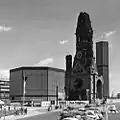Egon Eiermann
Egon Eiermann (29 September 1904 – 20 July 1970) was one of Germany's most prominent architects in the second half of the 20th century.

Eiermann was born in Neuendorf bei Potsdam (now part of Babelsberg, Potsdam), and studied at the Technical University of Berlin. He worked for the Karstadt building department for a time, and before World War II had an office with fellow architect Fritz Jaenecke. He joined the faculty of the university in Karlsruhe in 1947, working there on developing steel frame construction methods. He died in Baden-Baden, aged 65.
A functionalist, his major works include: the textile mill at Blumberg (1951); the West German pavilion at the Brussels World's Fair (with Sep Ruf, 1958); the West German embassy in Washington, D.C. (1958–1964); the highrise Langer Eugen for the German Parliament in Bonn (1965–1969); the IBM-Germany Headquarters in Stuttgart (1967–1972); and, the Olivetti building in Frankfurt (1968–1972). By far his most famous work is the new church on the site of the Kaiser Wilhelm Memorial Church in Berlin (1959–1963).
Eiermann worked as art director on the 1926 film The Pink Diamond.

 Olivetti Buildings in Frankfurt
Olivetti Buildings in Frankfurt Office building of DEA oil refinery, Karlsruhe
Office building of DEA oil refinery, Karlsruhe Langer Eugen, Bonn - detail of the facade
Langer Eugen, Bonn - detail of the facade